If you haven’t used storytelling in digital marketing, you may be missing a great opportunity to connect with your potential customers.
Storytelling activates parts of the brain responsible for feelings. And research shows that purchase decisions are as much emotional as rational. So if you want to convert visitors into customers, storytelling is the way to do it.
In this article you’ll discover:
- The three key ingredients of effective storytelling
- How to use storytelling for a brand
- How to use storytelling for a product or service
But first, why is storytelling in digital marketing so powerful?
Why Is Storytelling So Powerful?
By nature we are storytelling creatures. We’ve been telling each other stories for hundreds of thousands of years.
The result?
We’re hardwired to hear stories. To put it another way, the human mind is a story processor.
But why is storytelling so effective in marketing?
Storytelling activates parts of the brain that deal with the emotions. And it’s emotions, more than anything else, that make people buy things.
Here’s an example of the power of storytelling in marketing:
The Significant Objects Project bought 100 objects worth a total of $128.74
They then got 95 writers to write stories about those 100 objects and they put them up for sale on eBay.
Do you want to know how much they sold them for?
Those 100 objects sold for a total of $3612.51. In other words, storytelling increased the value of those objects by 2821.88 %.
That’s the power of storytelling.
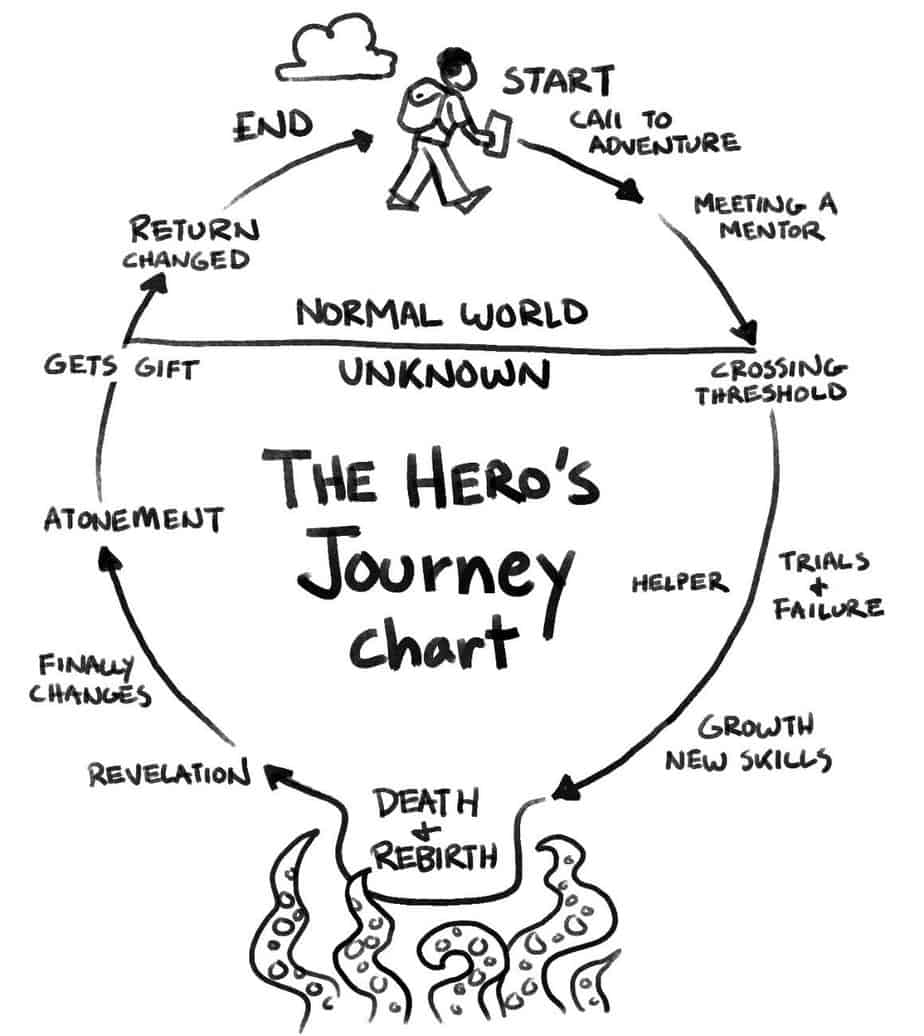
Storytelling and The Hero’s Journey
It was Joseph Campbell who first mapped out the universal elements of storytelling. These elements appear in all stories, in all places, in all times. In other words, storytelling is a universal language.
Here are some of the universal elements of storytelling:
From Known World to Unknown World
Entrepreneurs do this all the time.
They don’t know if their venture is going to work. It’s new territory. They’ve never been there before.
The beginning of any new undertaking can seem like a journey into the unknown.
Even something as small as starting a new article. There’s a little bit of fear there: is this going to work, can I pull this off?
The character goes through trials and failure
You must have read those ‘About’ pages where the person describes the low point in their journey.
They were divorced, $250,000 dollars in debt, and had a chronic illness.
Any good story needs conflict and these kinds of obstacles are part of the hero’s conflict.
Character learns new skills
The hero learns a new skill.
It might be guest blogging, it might be getting on Page #1 of Google, it might be public speaking.
Acquiring a new skill is part of the journey into the unknown. And while you’re doing it, it’s uncomfortable. That’s why successful people often advise others to “Get out of your comfort zone!”
Death and rebirth
This is your lowest moment, the moment you know it can’t get any worse.
It’s the darkest hour of the night, which happens to be just before dawn.
Character changes
Something has to change in the hero, otherwise there’d be no real journey, no transformation.
In a lot of business success stories it’s a change in attitude. It’s the realization: “I can do this”. For many of us, it’s taking hold of a power that we always had but were afraid to grasp.
Character gets a gift
This is where the hero is given a special gift. It might the power to pull a sword out of stone. Or it could just be the power to inspire others.
Character returns as changed person
The character now comes full circle. She returns to where she started. It’s the same place. But everything has changed.
Why?
Because she’s a new person.
These are the classic elements of The Hero’s Journey. You can find them in many popular stories, including:
- The Lord of the Rings
- Star Wars
- Harry Potter
- To Kill a Mockingbird
- The Story of King Arthur and Merlin
- The Lion King
- The Matrix
Of course, you don’t need all these elements for an effective story.
In fact all you need is three elements:
- A character (could be you, your customer, or your reader)
- Conflict (a problem that seems insurmountable)
- Resolution (the conflict is resolved)
Skilful marketers take their customers on the hero’s journey. They create stories that guide the customer through conflict and resolution.

Storytelling In Digital Marketing
Let’s look more closely at these three elements and see how they apply to storytelling in digital marketing.
Character
In content marketing, your characters are often your audience.
Your audience need to see themselves in your story. The character creates the connection between your product or service and your reader.
The first thing you need to do is define your character. For this, you need to look at your buyer persona.
What are the goals and challenges your buyer persona faces?
Conflict
One of the oldest stories around is the one about David and Goliath.
Israel is being threatened by the army of the Philistines. For 40 days Goliath has been taunting the Israelites. He’s challenging them to produce a warrior to fight him in hand-to-hand combat.
But Goliath is 9 feet tall and built like an ox. Not a single man amongst the Israelites dares to step up.
David is the youngest of eight brothers. He’s not even a warrior but a mere shepherd. His elder brothers are all seasoned soldiers. They laugh when he appears on the battlefield.
But he has two things his brothers don’t have – a fierce belief in God and a deadly accurate aim with a slingshot.
Your character needs a conflict: something where the odds seem stacked against them. It could be a problem they can’t solve. Something that’s preventing them from finding success.
Resolution
Where you have conflict, you must have resolution.
The reader wants to know how the story ends. Did the character overcome the obstacles? If so, how?
In our case, it’s your product or service that helps the character defeat her enemies.
Does this three-part formula seem familiar to you?
If so, it’s because blog writers use it over and over again to introduce their articles.
And it works every time!
Copywriters call it the PAS formula:
Problem – Agitate – Solution.
Here’s how it works:
- you set up a problem
- you agitate it and make it a bit worse
- and then you provide the solution
And here’s what it looks like in action:
It’s an awful moment, isn’t it?
You tap the window sill and it sounds hollow. You press a bit harder and your finger goes right through. What was once timber is now just a layer of paint. Your woodwork has been eaten away by termites.
But the nightmare isn’t over. When you see the quote from the pest control man you wonder where the money’s going to come from. And then there’s the quote from the carpenter. You suddenly realize you’re not taking the kids anywhere this summer holidays.
But what if I told you there’s a simple and very cheap treatment that means you’ll never ever see a termite in your house ever again?
Would you be interested?
If so, keep reading, because in this article I’m going to show you:
- a cheap chemical you can buy in your local hardware store
- where to apply it so that termites never enter your house again
- a simple way to check your house for termites without paying for an expensive inspection
Another key aspect storytelling in digital marketing is point of view (POV).
Your story’s point of view can be:
- first person
- second person
- third person
First person POV is what you find in stories on ‘About Me’ pages. The style in first person POV is often confessional.
The writer opens up and confesses that he was at the lowest point of his life. His wife had just divorced him and he was $250,000 in debt.
On top of that, he had a chronic illness that meant he didn’t even have the energy to make a cup of tea.
Second person POV is the point of view you often find on sales pages. This is where the writer describes in excruciating detail the pain points you’re facing.
It might go like this:
You spend a whole day doing keyword research.
You spend three days crafting a 5000 word article around your chosen keyword.
You optimize it for every On Page SEO factor known to man.
You hit publish and you wait.
Three days later it’s on Google. Its half way down page #2 but you’re sure it going to climb. After all, that’s what everyone says: SEO takes time.
But two days later it’s at the bottom of Page #2. And a week later it’s on Page #5.
A month later you can’t even find it anymore. You begin to realize that your monster blog post, that you spent nearly a week working on, is never going to bring a single visitor to your website.
Third person POV is found in ‘customer experience stories’.
They’re often in sidebars on a sales page. They describe how a customer went from frustration to success, using your product or service.
Here’s an example from Scott Dinsmore’s Live Your Passion course:
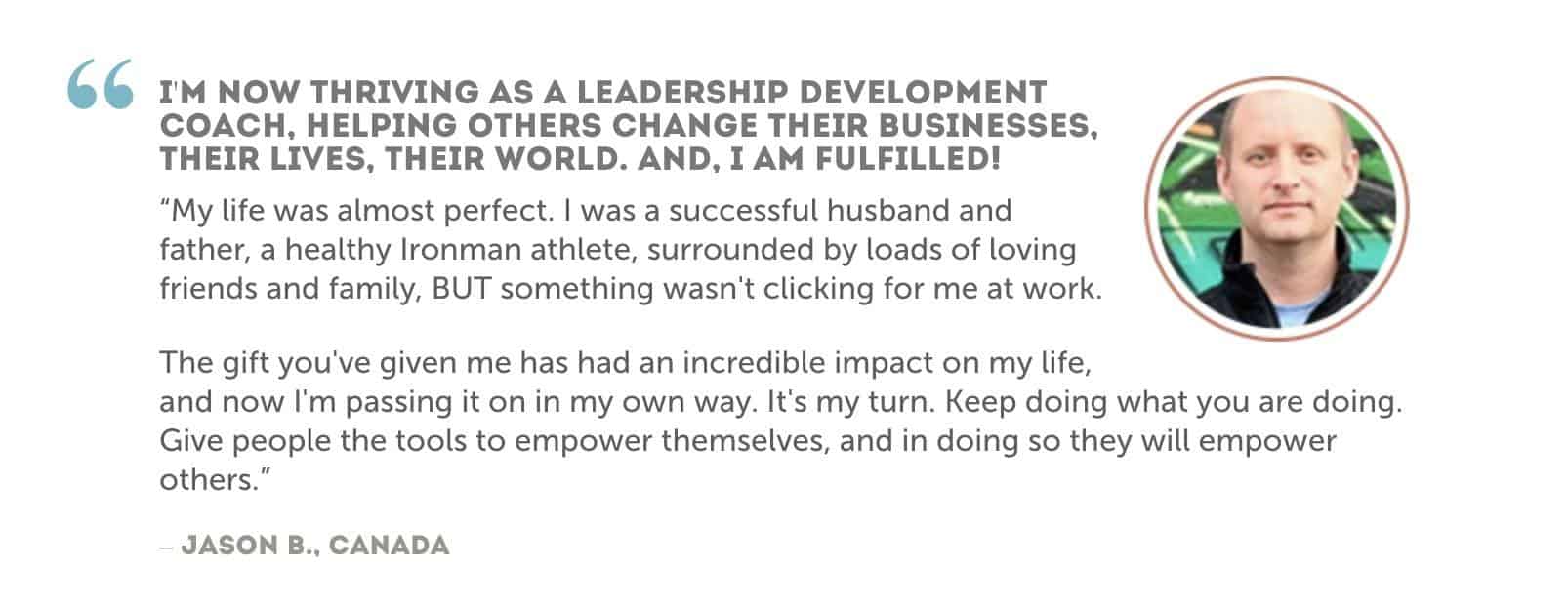
Telling a Brand Story
Sometimes the story you need to tell is not about a person, it’s about your company or brand. Storytelling for a brand is a way of building a connection with your audience.
You do that by making the story about your brand’s values.
If you’re telling a ‘brand story’, the story is why you’re doing what you’re doing.
Here’s an example:
In 2006 a guy called Blake Mycoskie was travelling in Argentina. He was struck by the hardships faced by children growing up without shoes.
So he started Toms Shoes, with the mission to give away a pair of shoes for every pair sold. He captured the mission in the tagline: “One for One”.
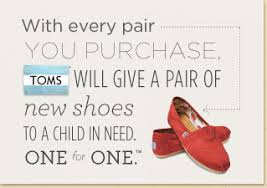
And that became the brand story for Toms Shoes.
These are the key steps in crafting a story around your brand:
- Define your key message:
- Know your audience
- Decide what story you’ll tell
- Convey your brand values
- Use contrast to make a stark distinction between choices
- Incite action
Here’s another example of brand storytelling.
Curt’s Special Recipe opens with a classic storytelling headline:
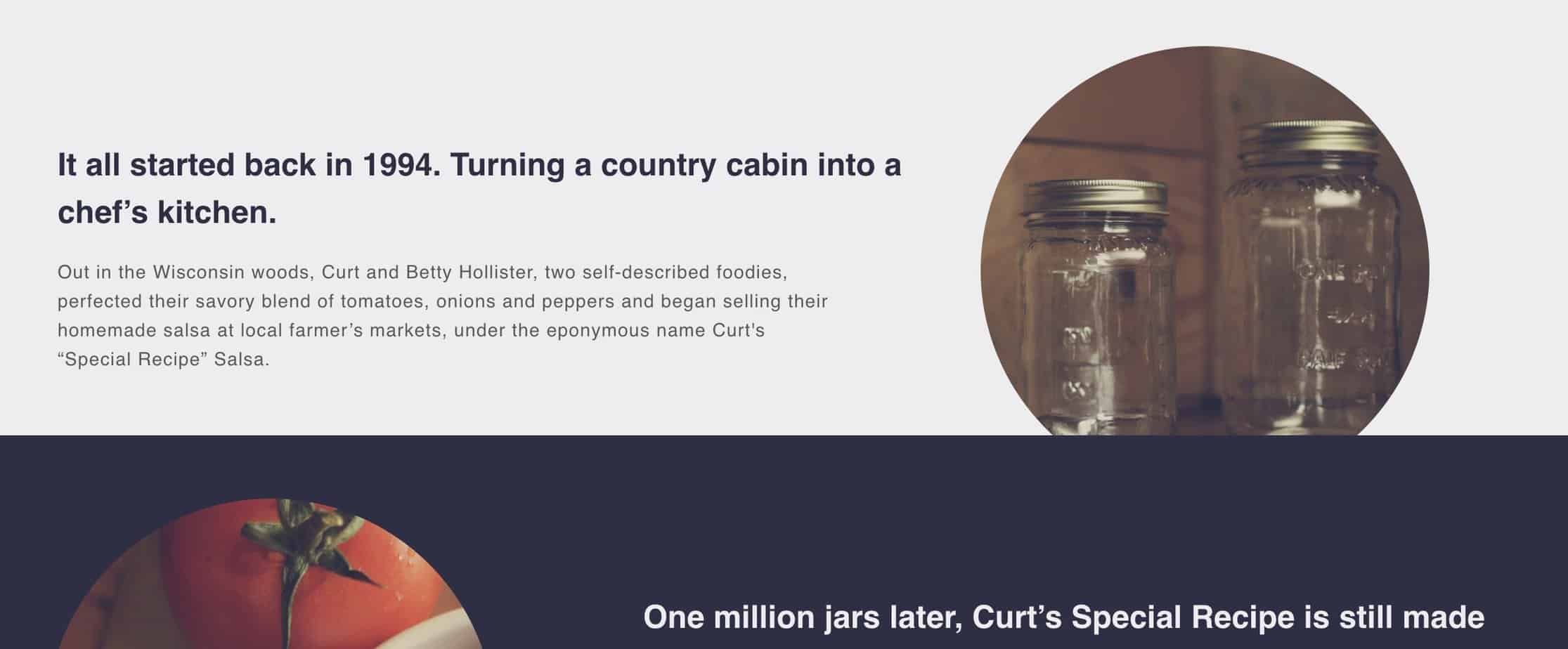
Examples of Storytelling in Digital Marketing
So what are some good examples of storytelling in marketing?
Jonathon Morrow
One of the best examples of storytelling in digital marketing is Jon Morrow’s account of how he started his blogging business.
The conflict appears right at the beginning of the story: “In April of 2006, I was hit by a car going 85 miles an hour.”
But the car accident was only the icing on the cake. He also had a degenerative disease called Spinal Muscular Atrophy. And it was costing him $127,000 a year in medical bills.
So he resigned from his job, sold everything he had, and moved to Mexico.
He started a blogging business, as a mentor for up-and-coming writers. Soon he was making so much money that PayPal shut his account down on suspicion of fraudulent activity.
But the most extraordinary part of the story is this:
Here was someone who couldn’t move anything from the neck down. By rights, he should have been in a nursing home watching television and waiting to die. But instead he was helping other people. He was changing other people’s lives!
A few years later he returned to the US from Mexico with a 6-figure business and bought his father a brand new car.
Jon Morrow’s story has some of the elements of the Hero’s Journey:
- moving from the known into the unknown
- trials and tribulations
- learning a new skill
- acquiring a gift
- returning a changed person
Brandon Gaille
Another good example of storytelling in digital marketing is Brandon Gaille’s journey from chronic illness and debt to a 6-figure blogging business.
Brandon found success in his twenties with a multi-million dollar startup. Soon he moved to Ireland and opened offices in Dublin and London.
He was thoroughly enjoying life! Meeting people in London cafe’s and soaking up the sights and sounds in one of the cultural capitals of the world.
But suddenly he struck down by a mystery disease. The doctors and specialists had no idea it was.
The medical bills piled up. By the time he was 30, the fortune he’d made in his twenties was all gone. Instead he was $390,000 in debt.
The diagnosis was a rare disorder called Dysautonomia. It meant he would have to sleep in a special room for 13 hours a night in a drug-induced state for the rest of his life.
Back on his feet, Brandon started another business and began blogging. He launched a blogging course and began coaching. Some of his clients were paying him $100,000 a year.
And that, in a nutshell, is the story behind Brandon’s multi-million dollar business Blog Millionaire.
Chad Mureta
Chad Mureta was a real estate agent in Myrtle Beach, South Carolina.
Driving home from work on evening, after putting in an 18 hour day, he hit a deer and rolled his car four times.
Lying in hospital, in debilitating pain, the doctors told him they would have to amputate one of his arms.
He had thought his life was bad before the accident. But now it seemed hopeless.
Lying on a table next to him in his hospital bed was an iPhone, the only thing that survived the car crash.
It was the beginning of the app gold rush and Chad came up with an idea: a fingerprint security app.
The developer fee for putting his idea into practice was going to be $1,800. He borrowed the money. It was long shot, and he didn’t know if the idea would fly.
But it did!
In its first month the app made him $12,000. It would go on to make Chad $620,000.
It was the start of a career in app building that made him a multi-millionaire.
Now of course, these are dramatic stories. They’re stories where the hero comes back stronger than ever after being almost annihilated.
I don’t have a story like that. And you probably don’t either.
But everyone has a story. Everyone is on a hero’s journey of some sort. We all have trials. At some stage we all go through a baptism of fire.
That’s the nature of life.
And you can use that story in your digital marketing.
Using Story on Sales Pages
Good sales pages make strong use of storytelling.
Storytelling creates alignment between your business and your customers. It creates emotional connection between your visitor and your product or service.
And that’s the first step in converting a visitor to a customer.
Storytelling on sales pages is most often in the 2nd person point of view.
On good sales pages you’ll see a lot of sentences beginning with the word ‘You’. The writer is telling lots of mini-stories where the main character is the reader themselves.
Shane Melaugh
Here’s an example from Shane Melaugh’s productivity course. Shane tells the story of someone who keeps running after the latest “thing” but never arrives.
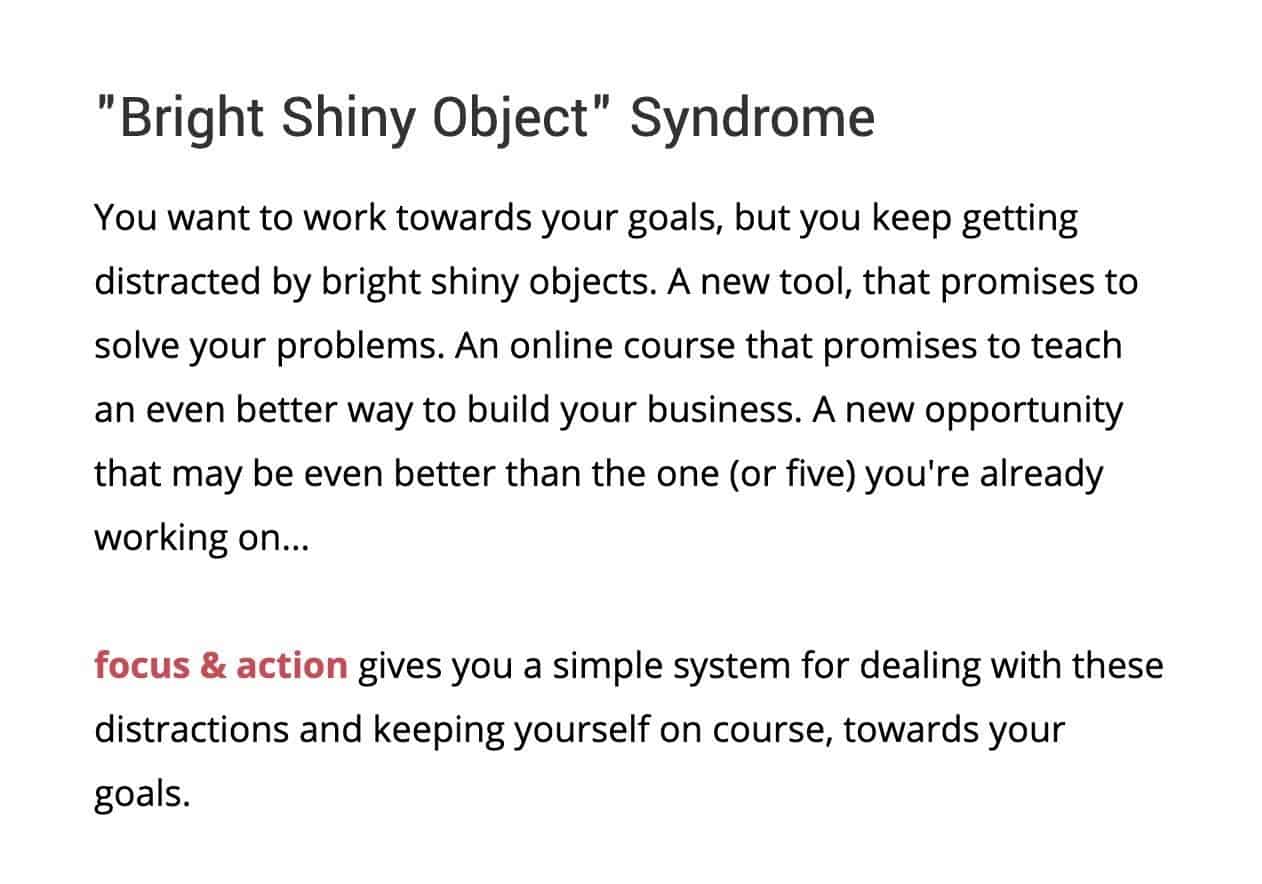
These you-focused stories are often interspersed with 1st person stories. Here’s an example from the same landing page.
The purpose of the storytelling in this excerpt is to establish empathy with the reader. Shane is saying “I was once where you are now”:
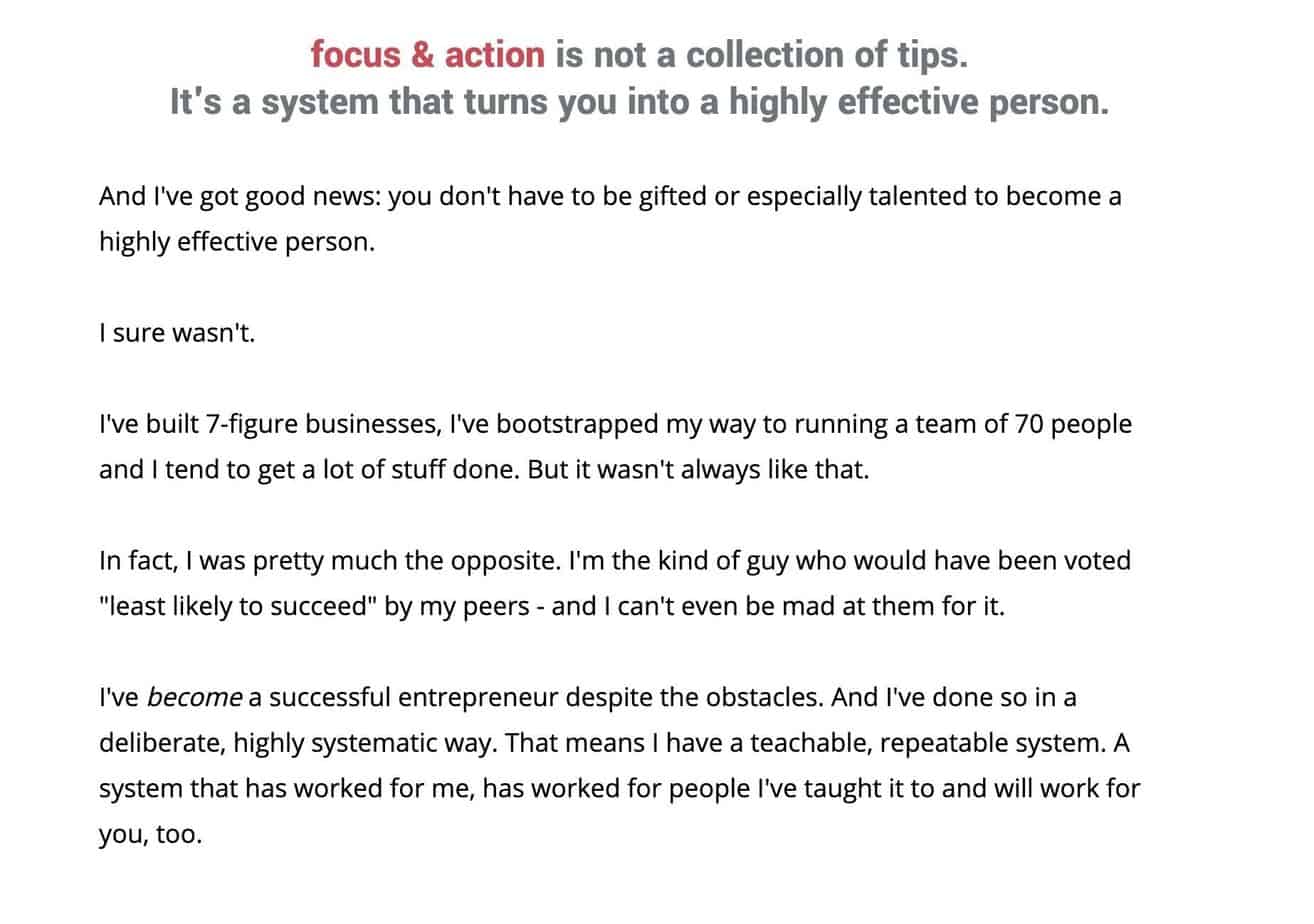
Dr. Mark Hyman
Storytelling on sales pages is often kept to a bare minimum, as on the landing page for Dr. Mark Hyman’s Eat Fat, Get Thin.
Here the storytelling is in the 2nd person.
It tells the story of someone who’s tired of following low-fat diets that don’t work. Its the story of someone who’s tired of being hungry, tired of counting calories, and wants results:

Tai Lopez
On the landing page for Tai Lopez’ 67 Steps Program, the storytelling is in the 1st person. It explains how his course is the product of his life experience inlcusing:
- travel to 51 countries
- investing in over a dozen multi-million dollar companies
- being mentored by 5 millionaires

Jeff Goins
Here’s another example of 1st person storytelling on a landing page. This one is from Jeff Goins’ Intentional Blog course.
The story is about how Jeff struggled with blogging for a decade before finding success. This kind of storytelling creates a connection with the reader. The writer is basically saying: “I know what it’s like to be you are – I was there for over a decade”.
The first thing a reader wants to know before even considering buying your course is this: does this person understand my problems? If they don’t, then you wouldn’t even consider taking their course.
So this approach to storytelling creates trust and establishes authority:
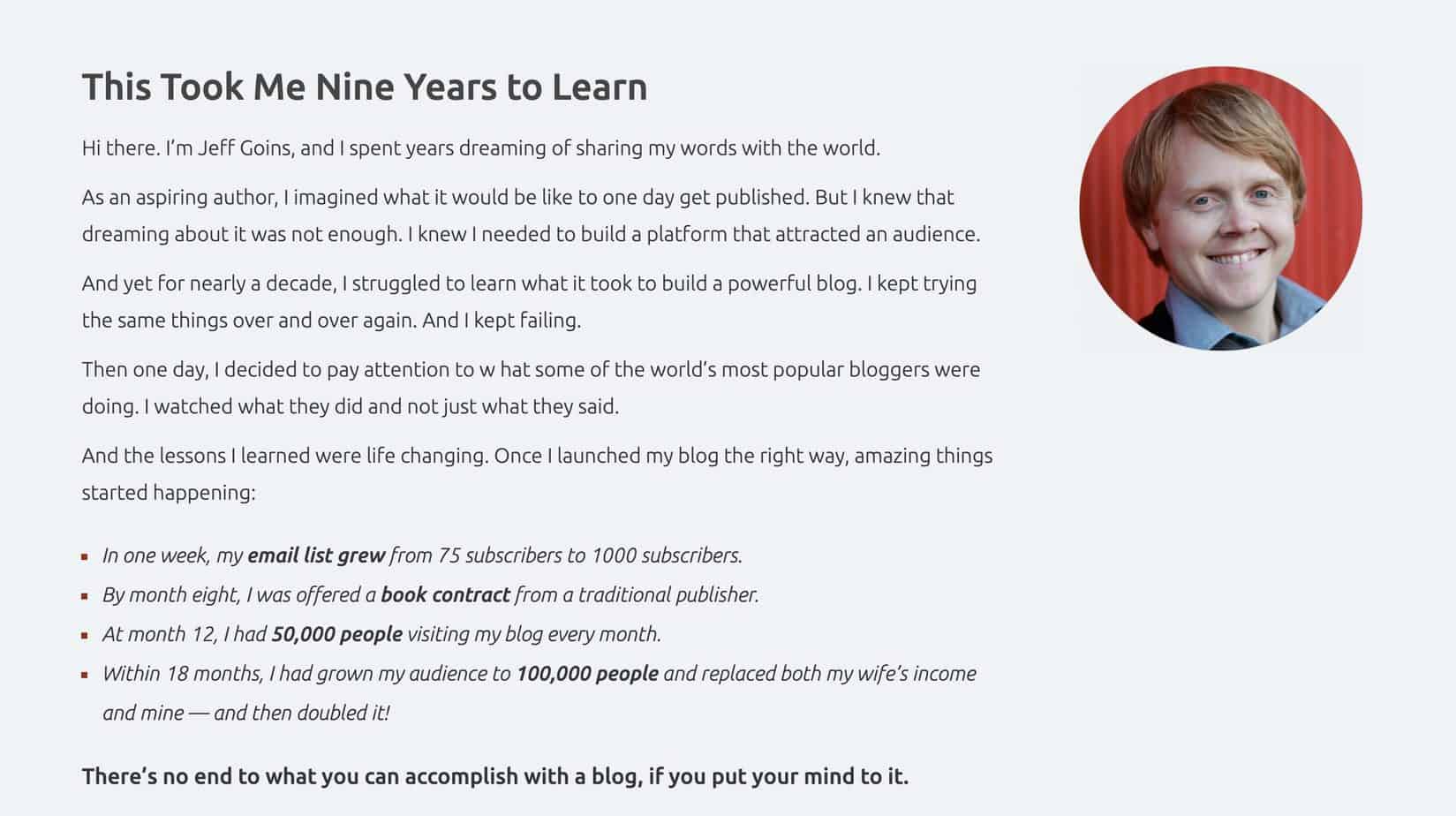
Paul Hollingshead
Here’s some strong 2nd person storytelling from the landing page of Paul Hollingshead’s AWAI course. The storytelling in this example paints a vivid picture of the kind of life that aspiring writers would like to have.
It uses lots of ‘you statements’ that get the reader to picture themselves in in Italian villa by the sea or on a Greek island in summer.
Admittedly, these are mini-stories. They are by no means a hero’s journey. But they tap into the stories that we all tell ourselves. Stories about how our lives could be…

Conclusion
We’ve been telling each other stories since the dawn of time. In fact, it’s probably hardwired into our DNA – we’re born storytellers.
So if you’re not telling stories in your articles, on your landing pages, and on your ‘About’ page, you’re leaving a lot on the table.
Here are the 7 key points for storytelling in sales:
- Storytelling on a website can be on your ‘about’ page and/or on a sales page
- All good stories have three elements: a character, conflict, and resolution
- If the story is on an ‘about’ page, it can be a personal story or the story of your company
- If the storytelling is on a sales page, the hero of the story has to be your customer, not your product
- Your audience need to see themselves in your story – it’s the character in the story that creates the connection between your product and your reader
- The story on a sales page should follow the PAS formula: problem, agitate, solution
- In your storytelling, the solution is your product
Use these elements in your online storytelling and you’ll get your readers’ full attention.
It’s our programing – we can’t help it.
Great article Rob. I’ve only recently started reading and researching the hero’s journey and how to use your writing to effect a transformation. So, it really helped me. I love the use of examples to illustrate your points. I find that every article of yours adds to my blogging education.
Well, what a nice little gem I found from someone sharing your post in my private FB group!
I love how you broke down storytelling into its components and showed the relationship it has to PAS. As I was reading this, I was thinking exactly that – well that’s just PAS and then a few lines down, you say just that!
I don’t think I’m the best storyteller, but I do my best to be in the shoes of my audience. I try to relate to them and try to understand their frame of mind when I write my sales pages and blog posts.
Thanks for the post and breakdown! I’ll be sure to tell my freelance writer audience!
Wow, This is very a comprehensive post on the power of story telling. Great post!. Thanks for sharing
Thanks Emmanuel, I’m glad it was useful – Rob
Hi Elna,
Great to see you here. I’m a big fan of your writing!
Thanks so much for the feedback, I’m glad it was helpful. I usually write about SEO but the response to this post has been great, so I’m thinking of doing more on the topic of ‘writing’. Thanks for the feedback about PAS – it occurred to me while writing the article that PAS is a kind of storytelling in miniature (Conflict followed by Resolution).
Thanks for the share as well!
All the best – Rob.
Hi Poovanesh, thanks so much for your feedback. Storytelling is a wonderful tool for bloggers. All the best, Rob.
Humans are emotional creatures. Storytelling allows us to digest information more easily because it connects that information to emotions. It is important because it is effective at teaching in a way that people can easily remember, and at helping people relate to one another.
Thank you Rob for such a wonderful article.
You’re welcome, Varum. Thanks for the feedback – Rob